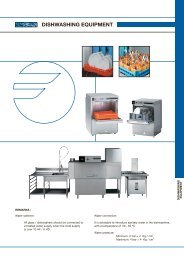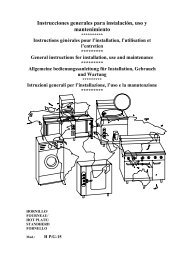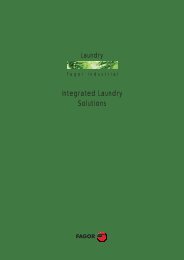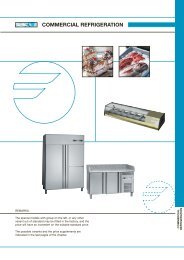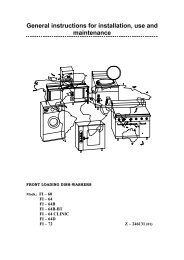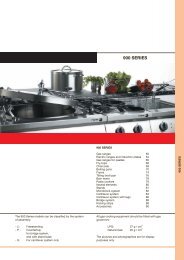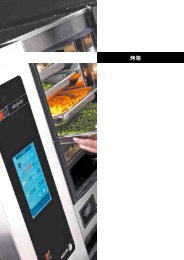General instructions for installation, use and maintenance - fagor
General instructions for installation, use and maintenance - fagor
General instructions for installation, use and maintenance - fagor
You also want an ePaper? Increase the reach of your titles
YUMPU automatically turns print PDFs into web optimized ePapers that Google loves.
<strong>General</strong> <strong>instructions</strong> <strong>for</strong> <strong>installation</strong>, <strong>use</strong> <strong>and</strong><br />
<strong>maintenance</strong><br />
*********<br />
GLASS-WASHERS<br />
Mods.: LVC - 12 LVC - 21B<br />
LVC - 15 LVC - 15D<br />
LVC - 21 LVC - 21D<br />
Z – 406132 (02)
Instalación con Motobomba<br />
desagüe<br />
Installation avec motopompe<br />
vidange<br />
Installation with drainage<br />
motor pump<br />
Installation mit motorbetätigter<br />
Abflußpumpe<br />
Installazione con motopompa<br />
di scarico<br />
LVC-12; LVC-15; LVC-15D<br />
LVC-21; LVC-21B; LVC-21D<br />
A=Toma de agua D=Manguera Desagüe E=Manguera eléctrica<br />
Prise d’eau Tuyau vidange Gaine électrique<br />
Water inlet Drain hose Electric s. Cable<br />
Wasseranschluß Schlauch Wasserauslauf Kabelschlauch<br />
Presa d’acqua Tubo di scarico Cavo elettrico<br />
Fig.1<br />
1
Fig. 5<br />
Fig. 2<br />
Fig. 4<br />
Conexión en regleta<br />
Raccordement sur réglette<br />
Strip connection<br />
Anschluß <strong>and</strong> die Leiste<br />
Connessione alla morsettiera<br />
(220-240V-1N~)<br />
Manguera<br />
Gaine<br />
S.cable<br />
H=Ablaß.<br />
Cavo<br />
(M)<br />
2 x 2.5 + T<br />
Fusibles<br />
F<strong>use</strong>s<br />
Siderungen<br />
Fusibili<br />
(F)<br />
20 A<br />
13 A<br />
Fig.6<br />
2<br />
Fig. 3<br />
S = Llave de corte–Robinet d´arret-Stopcock-Absperrhahn-<br />
Rubinetto di arresto<br />
F = Filtro-Filtre-Filter-Filter-Filtro<br />
H = Manguera-Tuyau-Hose-Schlauch-Tubo<br />
E = Electroválvula-Electrovanne-Electrovalve-Electroventil-<br />
Elettrovalvola<br />
B = Electrobomba–Electropompe-Electropump-<br />
Druckehöhungspumpe- Elettropompa<br />
C=Cubeta desagüe-Bac vidange-Drain collector-<br />
Abflußschale-Vaschetta di scarico<br />
D=Cubeta desagüe-Tuyan vidange-Drain hose-<br />
Kabelschlauch Wasserauslauf-Tubo di scarico<br />
Conexión red<br />
Raccordement secteur<br />
Mains connection<br />
Netzanschluß<br />
Connessione a rete<br />
(220-240V-1N~)<br />
am/ve=amarillo/verde<br />
jaune/vert<br />
yellow/green<br />
geb/grün<br />
giallo/verde<br />
a=azul<br />
bleu<br />
blue<br />
blau<br />
blu<br />
m=marrón<br />
brown<br />
braun<br />
marrone<br />
r=rojo<br />
rouge<br />
red<br />
rot<br />
rosso<br />
n=negro<br />
noir<br />
black<br />
schwarz<br />
nero
4<br />
1 5 4<br />
1 3 5 2 4<br />
1<br />
Figs. 7<br />
Figs. 8<br />
Figs. 9<br />
3<br />
2<br />
3
3 1<br />
6 2 4 5<br />
Fig. 11<br />
1<br />
2<br />
Oº 220º<br />
3<br />
4<br />
Fig.14<br />
5<br />
Figs. 10<br />
7<br />
6<br />
4<br />
Fig. 12<br />
l./h.<br />
1 0<br />
2 0,25<br />
3 0,75<br />
4 1,5<br />
5 2<br />
6 2,5<br />
7 3<br />
Fig. 13
1.- INSTALLATION<br />
1.1.- Installation diagrams<br />
See Fig.1<br />
1.2.- Positioning<br />
Level <strong>and</strong> adjust the height of the appliance. (Fig. 2)<br />
1.3.- Water connection<br />
− To be done as shown in figures 3 or 4.<br />
− Dynamic pressure necessary during rinsing: 2 - 4 Kg./cm 2 (3.5 ÷ 5 Kg./cm 2 ).<br />
− With mains pressures of less than 2 Kg/cm 2 (3.5 Kg./cm 2 )., install an electric pressure<br />
pump. (Fig.4).<br />
1.4.- Drainage<br />
a) Fix the drain hose as shown in Fig.5.<br />
b) Fit a siphon pipe to prevent bad smells.<br />
1.5.- Electrical connection<br />
− For access to the connection strip (R), (Fig. 6 <strong>and</strong> Fig. 1), remove the cover (T) <strong>and</strong> the<br />
rear panel (P). Connect the strip as shown in figure 6. Fix the sheathed cable in (E), leave<br />
enough cable to remove the electrical panel from the front.<br />
− Fit a general switch (I) independent of the appliance with a distance between contacts<br />
equal to or more than 3 mm.<br />
− The machine must be earthed.<br />
1.6.- Technical specifications<br />
MODEL<br />
Water inlet<br />
pressure<br />
Supply<br />
voltage<br />
Power(Kw)<br />
H. element Max<br />
Drum Tub absorb.<br />
Basket<br />
(mm)<br />
Cycle<br />
duration<br />
Min.<br />
Tub<br />
capacity<br />
(l)<br />
Rinse water<br />
consumpt<br />
(l)<br />
Net<br />
weig<br />
(Kg)<br />
LVC-12 1 34<br />
LVC-15<br />
LVC-15D<br />
LVC-21<br />
LVC-21D<br />
LVC-21B<br />
2÷4 Kg/cm²<br />
(28÷56psi)<br />
3.5÷5 Kg/cm²<br />
(42÷70psi)<br />
2÷4 Kg/cm²<br />
(28÷56psi<br />
3.5÷5 Kg/cm²<br />
(42÷70psi)<br />
2÷4 Kg/cm²<br />
(28÷56psi<br />
220-240V - 1N<br />
(50/60Hz.)<br />
2,4 2,66 350x350 11 2<br />
2<br />
2,8 3,06<br />
2,2<br />
2,66<br />
5<br />
400x400<br />
2 MAX.<br />
(Adjustable)<br />
2<br />
(Fixed)<br />
15 2,5<br />
36<br />
39<br />
42
2.1.- Use of the appliance<br />
LVC-12<br />
2.- USE<br />
− When the general switch is activated (1), Fig. 7, it lights up The wash drum <strong>and</strong> tub start to<br />
fill up. When the level is reached, the water is cut off automatically.<br />
− The cycle can be adjusted to a maximum duration of 2 minutes. Start by turning the control<br />
(5) clockwise. The pilot light comes on during the cycle (4) (Fig. 7).<br />
LVC-15; LVC-21<br />
− When the general switch is activated (1), Fig. 8, it lights up. The wash drum <strong>and</strong> tub start<br />
to fill up.<br />
− When the pilot light comes on (2), the machine is ready.<br />
− The cycle can be adjusted up to a maximum of 2 minutes. Start by turning the control (5)<br />
clockwise. During the cycle the pilot light comes on (4) (Fig. 8).<br />
− Press the switch (3) <strong>for</strong> a cold water rinse.<br />
LVC-21B<br />
− Set the switch (1), Fig. 9, to , the pilot light (2) will come on. The rinse <strong>and</strong> wash<br />
water will start to fill <strong>and</strong> heat up. When the pilot light comes on (3), the machine is ready.<br />
− Start the wash cycle by pressing (4). The programme is a set one <strong>and</strong> lasts 2 minutes.<br />
− To completely empty the tub, remove the anti-overflow device (A) (Fig. 13), set the switch<br />
(1) to <strong>and</strong> press button (4) (Fig. 9).<br />
− At the end of the day set the switch (1) to the 0 setting.<br />
LVC-15D; LVC-21D<br />
− Set the switch (1), Fig. 10, to the pilot light (2) will come on. The filling <strong>and</strong> heating<br />
up of the rinse <strong>and</strong> wash water will start.<br />
− When the pilot light comes on (4) the machine is ready.<br />
− The cycle can be adjusted up to a maximum of 2 minutes. Start by turning the control (6)<br />
clockwise. During the cycle the pilot light (5) (Fig. 10) will come on.<br />
2.2.- Regeneration of the water softener<br />
Models LVC-15D, LVC-21D, have a water softener which should be regenerated at the end<br />
of the day. To do this, carry out the following operations:<br />
− Set the switch (1) (Fig. 10) to<br />
− Remove the anti-overflow device (A) (Fig. 13).<br />
− Press the switch (3) (Fig. 10) <strong>for</strong> a few seconds until the pilot light comes on (5)<br />
− After about 20 minutes the pilot light will go off (5) (Fig. 10) indicating that the<br />
regeneration cycle is complete.<br />
− Fill the tank each week with common salt, hermetically closing the lid (T) (Fig. 11).<br />
6
2.3.- Advice on how to wash correctly<br />
− Add the detergent dose to the dish washer compartment or to the detergent dispenser if<br />
fitted, adjusting it to the dose recommended by the manufacturer (Fig.14).<br />
− Control <strong>and</strong> maintain the level of rinse aid in the tank <strong>and</strong> the pipe with its filter<br />
submerged.<br />
Preparing the crockery<br />
− Remove the biggest bits of food from the crockery be<strong>for</strong>e putting it into the baskets.<br />
− Put cups <strong>and</strong> glasses in upside down..<br />
− Put cutlery in the cutlery baskets with the h<strong>and</strong>le at the bottom. Mix spoons with knives<br />
<strong>and</strong> <strong>for</strong>ks.<br />
− Put the special cutlery baskets in the base basket.<br />
Cold rinse<br />
For a cold rinse press the switch (3) (fig.8) in models LVC-15, LVC-21 <strong>and</strong> set the switch to<br />
the setting in models LVC-21B, LVC-15D y LVC-21D (Figs.9, 10).<br />
7
3.- MAINTENANCE<br />
− In machines without a detergent dispenser, put in 1 dose every 10 washes.<br />
− Check the detergent <strong>and</strong> rinse liquid containers.<br />
− Clean (F) everyday. To do this release the anti-overflow device (A), turn it anticlockwise<br />
<strong>and</strong> lift. Then replace (F) putting the lugs into the slots <strong>and</strong> turning anticlockwise (Fig. 13).<br />
− If the machine is not going to be <strong>use</strong>d <strong>for</strong> a long time, cover its surfaces with a coating of<br />
petroleum jelly.<br />
− Use soap <strong>and</strong> water <strong>for</strong> cleaning purposes, not abrasive detergents. Do not <strong>use</strong> jets of water<br />
to clean the outside of the machine.<br />
3.1.- Electrical <strong>and</strong> mechanical problems<br />
Be<strong>for</strong>e calling <strong>for</strong> service, check;<br />
− If the machine is plugged in to the power supply.<br />
− The voltage coincides with that of the machine.<br />
− If the water connection or the start up take too long:<br />
Check the water supply.<br />
Check if the filter in the electrovalve (Fig. 4).<br />
If it does not rinse properly, check:<br />
− That the water inlet filter is not blocked. (Fig.4)<br />
− That the mains water pressure is between 2 - 4 Kg/cm 2 (28 - 56 psi).<br />
− That the arms rotate properly <strong>and</strong> the nozzles are not blocked. Wash the rinsing arm<br />
releasing the screw in the axis. To release <strong>and</strong> tie up the screw <strong>use</strong> a coin.<br />
− The rinse aid liquid level.<br />
If it does not wash correctly, check;<br />
− That the wash arms rotate properly <strong>and</strong> the injectors are not blocked.<br />
− That the suction filter is not blocked <strong>and</strong> properly in place.<br />
− Verify that the detergent dose is the correct one.<br />
3.2.- Optional accessories<br />
The manufacturer has the following optional accessories which can be fitted to the machine.<br />
− Dispenser kit<br />
− Electric pressure pump<br />
− Liquid detergent dispenser<br />
− Anti-return valve<br />
NOTE.- THE FINAL HOLDER OF THE CONTAINER WASTE IS<br />
RESPONSIBLE FOR ITS MANAGEMENT.<br />
8



